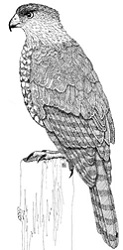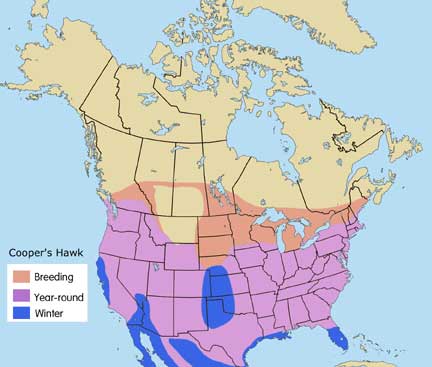
Scientific Name: Astur cooperii
A medium-sized accipitrid, it is always larger than the similarly feathered Sharp-shinned hawk. Identification in the field, however, is difficult. The Cooper’s hawk is considerably smaller than the Goshawk; however, the juvenile Goshawk has similar plumage. It is the most slender and long-tailed of the accipitrid hawks. With experience it can be identified by its shape and stiff wing beats. A very aerodynamic bird, its shape and long-toed foot is especially successful in hunting birds.
Female is approximately 1/3 larger than male but both sexes are similarly colored. The back and upper wings of this species, in adult plumage, is brown to blue-gray while the underparts are barred red in color. Like other woodland hawks, the wings are short, round and powerful. The tail is rather long and round with 4 bands of light and dark. Legs are yellow with extremely long toes. Eyes turn a red-orange color in adult birds.
Male
Length: 15″
Wingspan: 8-9″
Weight: 9-12 oz.
Female
Length: 17″
Wingspan: 10-11″
Weight: 15-18 oz.
Protected under both state and federal laws; during the mid-1990’s population decline occurred in the eastern United States. Shooting, trapping and pesticides are thought to be responsible for the decline.
Woodlands and edge of woodlands, though will hunt in the open. Will be found hunting around houses and birdfeeders pursuing song birds attracted to feeders.
Diet consists of mid-size birds and mammals taken often in a surprise attack. Relies on concealment and maneuverability to shield its approach to prey. It is thought that the difference in size between males and females (females being significantly larger than males) helps in resource allocation.
A series of flat nasal barks pek pek pek can be heard at the nest site. Vocalization is thought to be the primary means by which nesting pairs communicate in their dense woodland habitat. During non-breeding season this species is usually silent. The alarm call cak cak cak is most often heard in the field.
Nests in extensive forests and smaller woodlots. Compared to the sharp-shinned hawk it tends to nest in older and taller trees. Typically builds nest of sticks that are placed in the main crotch of the tree. Often nests are concealed by the canopy. Will build nests on top of abandoned nest sites.
This species will often fly into windows while chasing prey. Will also tangle in fencing or netting or be hit by cars. Historically shooting and trapping caused a significant decline in eastern populations, as did DDT poisoning.

Found throughout much of North America, including northern Mexico, and southern Canada.
Special Thanks for range maps:
Dan Gleason
BGleason Design & Illustration
Commercial & Scientific Illustration, Graphic Design
CraneDance Communications
Book Production/Design

